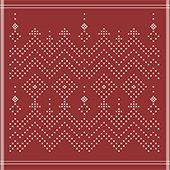Computer Aided Design (CAD) in textile designs refers to the application of computer software to create, manipulate, and visualize designs for textiles. CAD allows designers to digitally design motifs and patterns. This technological tool enables precise control over colour, scale, and repeat patterns, facilitating the creation of intricate and detailed designing. It helps to visualize the design and pattern on fabrics along with colours.
There are multiple weaving softwares available but most of them are highly complicated and designed for industrial use and especially for power-looms. They are less suitable for designing handwoven textiles. The software for designing handwoven textiles was selected considering the following aspects: the software should be easy to use so that anyone who is not so familiar with the technology can also use it without assistance. In handwoven textile, where the weaving is done on a completely hand operated loom, the designing requires a lot of planning for the weaver depending on whether it is warp based design or weft based design or both. The planning starts from the very first step of warping. Hand-weaving process is complicated and time-consuming. For a handloom weaver to use a designing software, it should be simple and user friendly.
For textile design, Photoshop is largely used as design and editing software, which is also easy to use, convenient to play with the motifs and their placements, user friendly for creating layouts and exploring colour-ways. Considering these points in mind, the researcher has selected Photoshop as a digital designing tool to replace manual designing, which is time consuming.
This step-by-step instructional material is created to assist learners in designing handwoven textile patterns using Computer-Aided Design (CAD). It covers the basic tools for creating woven designs, motif development, layout creation, and generating colourways of woven textiles in CAD. The material also guides learners in developing motifs and layouts for three traditional handwoven textiles of India, specifically from the Gujarat region: Dhabla of Kachchh, Tangaliya of Surendranagar, and Ashavali saris of Ahmedabad.



